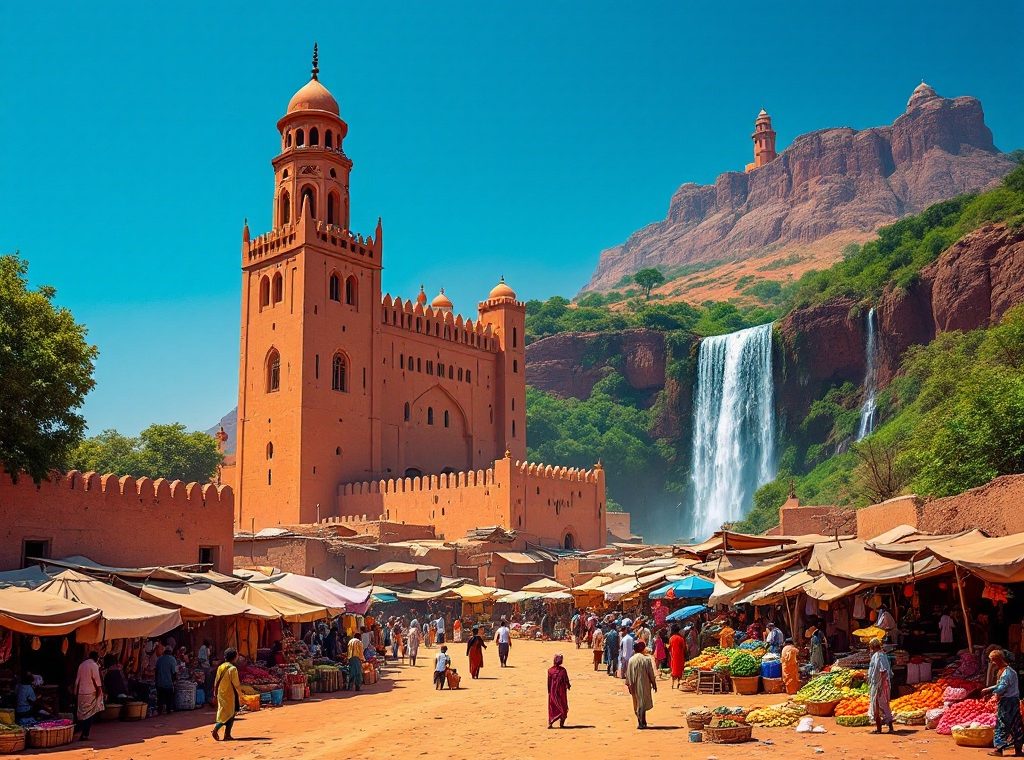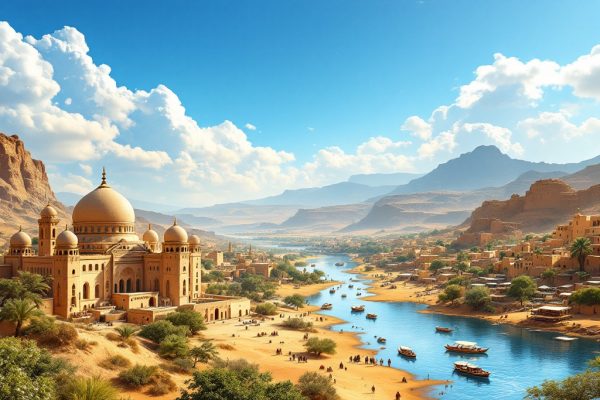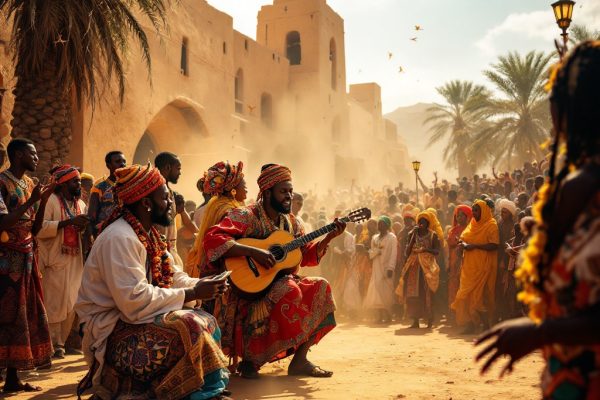Mali Tourist Attractions for a Weekend: Discover the Beauty of West Africa
Dreaming of an African adventure? Explore ancient cities and stunning landscapes in Mali! Discover the Great Mosque of Djenné, a UNESCO World Heritage site, and the historic Djinguereber Mosque. From bustling markets in Bamako to the tranquil beauty of Siby Waterfall, Mali offers a unique travel experience. Plan your unforgettable journey today!
Important information

- Explore key historical sites like the Great Mosque of Djenné (a UNESCO World Heritage site and the largest mud-brick structure globally), the Djinguereber Mosque in Timbuktu, and the Tomb of Askia in Gao.
- Experience Malian culture through visits to the Musée National de Bamako, the vibrant City Centre Market, and traditional markets offering local crafts, and by savoring local cuisine like Tigadegena and Maafe.
- Consider a day trip to Siby for natural attractions such as the Siby Waterfall and the Manding Mountains, offering hiking and scenic views.
- Transportation options include taxis, buses, and private cars. Hiring a local guide is recommended for navigation and safety, especially given unpredictable road conditions.
- For accommodation, choose from local guesthouses for a cultural experience or hotels near major attractions for convenience.
Planning Your Weekend Itinerary in Mali
Plan your perfect weekend getaway to Mali!
Visit the Great Mosque of Djenné early in the morning to avoid large crowds.
Explore the stunning Bandiagara Escarpment with a guided tour.
Discover Timbuktu’s historical manuscripts with insights from a local guide.
Indulge in Malian cuisine and experience the vibrant culture during the evenings.
For a comprehensive experience:
- Bamako,
- Ségou,
- Djenné,
- Siby.
For a shorter trip:
Focus on Bamako and its surrounding attractions.
Accommodation Options: Where to Stay
Planning a trip to Mali? You’ll discover a variety of accommodations to fit your budget and preferences. For budget-conscious travelers, local guesthouses offer an authentic cultural experience and warm Malian hospitality. If comfort and convenience are paramount, consider hotels near major attractions. Excellent choices include hotels near the Great Mosque of Djenné and Timbuktu’s Djinguereber Mosque. In Bamako, the capital city, numerous hotels and guesthouses are conveniently located near attractions such as the Musee National and the bustling City Centre Market. Nature lovers can find accommodations near Siby or enjoy the scenic beauty of the Manding Mountains.
Accommodation Type
- Local Guesthouses: experience authentic Malian culture and hospitality.
- Hotels: prioritize convenience and comfort, often located near major attractions.
Recommended Locations
- Djenné: stay near the Great Mosque of Djenné.
- Timbuktu: find hotels close to the Djinguereber Mosque.
- Bamako: explore the Musee National and the City Centre Market.
- Siby & Manding Mountains: ideal for nature enthusiasts.
Getting Around Mali: Transportation Tips
Traveling in Mali can be challenging, so consider hiring a local guide to navigate the country’s complexities. Various transportation options exist, including taxis, buses, and private cars. Be aware that road conditions can be unpredictable, so seek local advice for optimal routes. Prioritize your safety by heeding travel advisories, particularly in volatile areas, and avoid large crowds. For a safer and more enriching journey, guided tours offer both security and valuable local insights into Mali’s vibrant culture. Here’s a breakdown of key travel tips for Mali:
Transportation
- Taxis are readily available, but negotiate fares beforehand.
- Buses offer a more affordable option for longer distances.
- Private cars provide greater flexibility, but road conditions vary.
Safety
- Consult travel advisories for up-to-date information on safety risks.
- Be cautious in crowded areas, especially in volatile regions.
- Consider hiring a local guide for enhanced safety and cultural insights.
Historic Sites to Visit in Mali
The Great Mosque of Djenné, the world’s largest mud-brick structure, stands as an iconic example of Sudano-Sahelian architecture and a UNESCO World Heritage site. It showcases the impressive earthen building techniques of the region.
The Djinguereber Mosque in Timbuktu, dating back to 1325, is part of the historic University of Timbuktu. This mosque exemplifies the rich earthen architecture of the area.
The Tomb of Askia in Gao, a unique pyramidal structure built in 1495 by Emperor Askia Muhammad, is another UNESCO site. It beautifully blends Sahelian and Islamic architectural styles.
The Bandiagara Escarpment, a sandstone cliff in Dogon country, reveals ancient cave dwellings and Tellem villages. It offers a fascinating glimpse into the area’s rich history and culture.
Great Mosque of Djenné: Iconic Mud Architecture
The Great Mosque of Djenné, the world’s largest mud-brick structure, stands as an iconic example of Sudano-Sahelian architecture. Constructed in the 13th century using banco, a traditional mud-building technique, it reflects Mali’s rich cultural and spiritual heritage. A vibrant replastering festival unites the community each year to restore the mosque’s exterior, powerfully demonstrating local culture and reinforcing cherished traditions.
Djinguereber Mosque: Built in 1325
Completed in 1325, the Djinguereber Mosque stands as a prominent landmark in Timbuktu.
Its striking mud-brick architecture showcases intricate designs.
Historically, the mosque housed an extensive library, renowned as one of the world’s largest and a hub for Islamic scholarship.
Tomb of Askia: UNESCO World Heritage Site
Completed in 1495, the Tomb of Askia stands as a tribute to Askia Muhammad Touré and a testament to Sahelian mud architecture. This UNESCO World Heritage Site is the final resting place of Touré, who greatly expanded the Songhai empire. The tomb also symbolizes the region’s rich Islamic heritage, representing both a powerful leader and a vibrant culture.
Bandiagara Cliffs: A Historic Marvel
Mali’s Bandiagara Escarpment, a UNESCO World Heritage site, is a 150-kilometer sandstone cliff in Dogon country. It is renowned for the Dogon people’s unique architecture, including ancient cliff dwellings. The escarpment holds deep cultural significance for the Dogon people and their rich traditions. Visitors can enjoy popular activities like hiking and trekking, taking in the breathtaking views of the stunning landscape.
Cultural Experiences and Markets in Mali
The Musée National de Bamako showcases Malian art and artifacts, offering a fascinating glimpse into the country’s rich cultural heritage.
Bamako’s vibrant City Centre Market is a must-see for visitors, brimming with diverse goods such as textiles, crafts, food, and aromatic spices.
For unique handcrafted souvenirs, explore Mali’s traditional markets, where you’ll discover exquisite jewelry, pottery, and textiles reflecting local artistry.
Don’t miss the chance to savor Malian cuisine, with flavorful dishes like Tigadegena, a peanut butter stew, and Maafe, a rich groundnut sauce, offering a true taste of local flavors.
Musee National de Bamako: Art and Artifacts
The Musée National de Bamako showcases a diverse collection of Malian artistry, from vibrant textiles and earthenware to ancient tools. Visitors can also admire traditional masks and elaborate wood carvings, offering a unique window into Mali’s rich cultural legacy. A journey through the museum reveals the country’s captivating history. Explore the following:
- Textiles: Discover vibrant, handwoven cloths, showcasing traditional Malian patterns and techniques.
- Earthenware: Examine a variety of pottery and ceramics, reflecting both utilitarian and artistic purposes.
- Ancient Tools: Gain insights into the daily lives and ingenuity of Mali’s past inhabitants.
- Masks and Carvings: Admire the intricate details of traditional masks and elaborate wood carvings, central to Malian ceremonies and rituals.
Bamako City Centre Market: A Must-Visit
Experience the vibrant heart of Bamako at the City Centre Market. This bustling hub offers an authentic glimpse into Malian life. Discover a diverse array of goods, from traditional crafts and colorful textiles to delicious local cuisine. It’s a true feast for the senses. More than just a shopping destination, the market provides a profound cultural immersion, essential for understanding Bamako. Soak in the atmosphere and uncover the true spirit of Mali.
Traditional Markets: Discover Local Crafts
Experience the heart of Mali’s culture at its vibrant traditional markets. Discover unique, handcrafted treasures, including textiles, pottery, and jewelry, each reflecting the nation’s artistic legacy and offering a glimpse into its rich history.
Malian Cuisine: A Taste of Local Flavors
Experience the vibrant flavors of Malian cuisine. Indulge in dishes like Tigadegena, a rich peanut butter stew, and Maafe, a savory groundnut sauce. Savor La Capitaine Sangha, a crispy fried fish. Discover these tastes through immersive cooking classes or enjoy authentic meals at local restaurants. Explore traditional markets and sample diverse street food offerings for a true taste of Malian life.
Day Trips and Natural Attractions
Escape the bustle of Bamako with a day trip to Siby, Mali, a town renowned for its stunning landscapes. The Siby Waterfall offers a refreshing oasis where you can swim and hike amidst natural beauty. For breathtaking panoramic views, venture into the accessible Manding Mountains. Siby’s unique blend of adventure and tranquility promises a memorable experience.
Siby: Ideal for a Day-Trip from Bamako
Escape the hustle of Bamako and discover the tranquil oasis of Siby, a perfect day trip in Mali. Witness the country’s natural splendor, culminating in breathtaking views from the Arch of Kamandjan—a true must-see. Immerse yourself in local culture by exploring vibrant markets and interacting with the friendly residents. For nature enthusiasts, hiking and trekking through the Manding Mountains offer an invigorating connection with the landscape. Siby promises a memorable day trip.
Siby Waterfall: Natural Beauty and Adventure
Escape Bamako’s vibrant city life with a refreshing day trip to the captivating Siby Waterfall, nestled an hour away in the serene countryside. Hike to the majestic arch of Kamadjan for breathtaking scenic views. Immerse yourself in the local culture by exploring nearby villages and engaging with the warm Malinke people. The Manding Mountains offer challenging trails leading to dramatic cliffs and fascinating rock formations. Experience everyday life at the bustling weekend market, a vibrant tapestry of the region’s rich culture.
Manding Mountains: Scenic Landscapes
Discover Mali’s natural beauty with a hike through the stunning scenery of the Manding Mountains. Explore breathtaking landscapes and enjoy an unforgettable experience.
Unique and Unusual Things to Do in Mali
The Antogo Fishing Frenzy is a remarkable Malian tradition. Each year, the entire village gathers at a small, shrinking pond for this vibrant event, attracting both locals and tourists.
Mali is a country brimming with hidden gems. Bamako, for instance, boasts a traditional medicine market filled with unique healing items. It also has a bustling artisan market offering authentic crafts.
The Grand Mosque provides a glimpse into Islamic culture. Observing sand collectors along the Niger River offers fascinating insight into local building practices.
Antogo Fishing Frenzy: Cultural Tradition
Mali’s Antogo Fishing Frenzy is a cherished tradition deeply rooted in local fishing practices and community bonds. This vibrant event offers a glimpse into the country’s rich cultural heritage.
Hidden Attractions: Secrets of Mali
Discover the hidden wonders of Mali. Explore Bamako’s fascinating medicine market and witness traditional healing practices. Observe how locals collect sand from the Niger River, a vital resource for construction. Venture beyond the city to discover more of Mali’s treasures. The Arch of Kamandjan in Siby offers breathtaking views. Visiting local villages provides opportunities to connect with artisans and experience Mali’s rich artistic heritage. Immerse yourself in the vibrant culture at the Festival of the Niger, a true celebration of Malian traditions.














